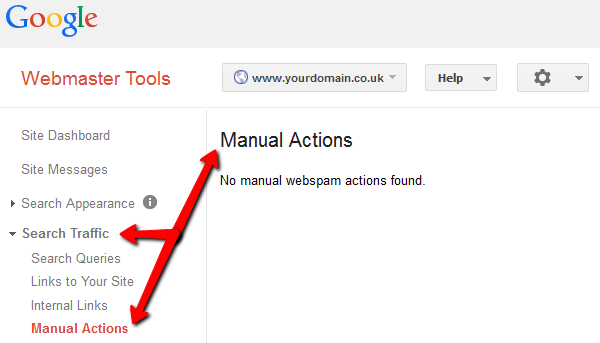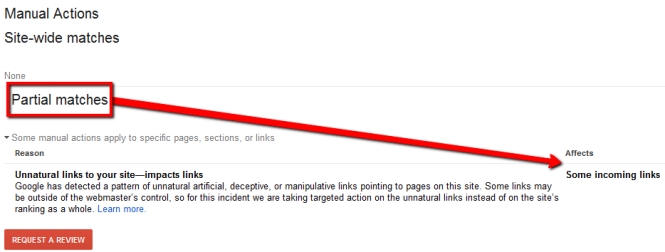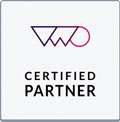Welcome to the first in a five part series in which I’ll cover the whys and hows of Google manual penalties.
Manual webspam penalties can significantly limit organic search visibility therefore substantially limiting organic reach. In certain instances the severity of a manual penalty can be such that it can potentially eliminate a brand from search in it’s entirety. Recovery from any manual penalty is not easy. There is no magic wand. You’re going to have to work hard, invest in resources and/or employ the services of an external agency to help revoke the manual action.
I’ve been instrumental in the development of High Position’s penalty removal service therefore I thought I’d share some knowledge with you through this series of posts. I’ve worked closely with each penalty removal project to identify and understand the reasons behind the serving of each manual penalty therefore I have a wealth of knowledge, and whilst I’m not going to divulge our secret link removal recipe, I will give you a nudge in the right direction.
In this weekly series I’ll aim to cover:
Part 2 - What Constitutes a Link Penalty?
Part 3 - Performing a Link Audit - coming soon
Part 4 - When to Disavow? - coming soon
Part 5 - Reconsideration Request Best Practice - coming soon
So let’s get started!
To facilitate the removal of manual webspam action it is first vital to understand the type of action applied, what the action relates to and the severity of the manual action taken against your website. With this in mind here are a few things you should be aware of.
Manual vs Algorithmic Penalties
Before we delve into the understanding of a manual webspam action let’s first clarify the difference between a manual penalty and an algorithmic penalty so there’s no confusion.
Manual penalties occur when Google place a manual restriction on your website’s rankings due to clear violation of webmaster quality guidelines. Manual penalties are Google’s attempt to manually remove spam or websites which participate in spam (intentionally or unintentionally) from their search results.
Google are pretty helpful when it comes to the identification of a manual webspam action and provide notification within Google Webmaster Tools as to what action may have been taken. Likewise Google have also become considerably better and more consistent at sending notifications to webmasters (via email) when manual webspam action is taken.

If you’re not sure whether you’ve been hit with a manual action go to Google Webmaster Tools and check ‘Manual Actions’ under the ‘Search Traffic’ drop down. If you’re not already verified with Google Webmaster Tools do it now! Hopefully you’ll see a message which says “No manual webspam actions found” meaning you’re in the clear. If not then I strongly recommend you keep reading!
Algorithmic penalties theoretically occur when Google algorithmically detect an issue with your website; however it’s not quite that clear cut.
Contrary to popular belief algorithmic penalties are somewhat of a myth. Google themselves do not think in terms of algorithmic “penalties”. Instead they think of search ranking in a holistic manner through which it’s difficult to determine the source of any loss in search ranking from one part of the ranking algorithm to another. Google’s Matt Cutts said in a recent Google Webmasters video talking about algorithmic penalties:
“The bad news is that it’s a little hard and difficult to say whether you call it a penalty or not, it’s just a part of ranking. The good news is, it is algorithmic, and so if you modify your site, if you change your site, if you apply your best guess about what the other site is doing that you should be doing or that it is doing well, then it’s always possible for the algorithm to rescore your site or for us to recrawl and reindex the site and for it to start ranking highly again”
So algorithmic “penalties” may be much harder to determine the cause of, but being algorithmic means you can vary the techniques used and Google will algorithmically re-evaluate your website. Isn’t this trial and error? Yes, pretty much! But if you have a good knowledge of on-page and off-page optimisation techniques you can ensure you utilise best practice techniques and add a little science to your trial and error process.
Although algorithmic penalties are harder to solve if you’ve noticed a significant drop in search ranking or search traffic around a particular date it may be possible to associate that loss with a particular algorithm update, in which case you may be able to determine a possible cause for your loss. Check out our Google algorithm history page for an up to date list of all the major algorithm updates.
Reasons for a Manual Action
When people think of manual webspam action most will think of a link related penalty which, to be fair, cover the vast majority of manual actions in my experience. But not all manual penalties relate to unnatural link practices. In fact there are several types of manual action including:
- Unnatural links to your site
There are two types of unnatural links to your site. The first will be applied with the message “impacts links” whereby Google will take targeted action against particular inbound links. The second will not have the “impacts link” notice and occurs when action is taken against your website not just the offending inbound links.
- Unnatural links from your site
Occurs when Google detects outbound links on your website in breach of search quality guidelines. This may include the use of techniques such as reciprocal linking schemes, link lists/directories, irrelevant or otherwise spammy links, or paid linking schemes.
- Hacked site
Manual actions against a hacked site can occur when your website has been unwittingly compromised by a third party. In this instance users may be being served incorrect, irrelevant or harmful pages due to a malicious attack on your website.
- Thin content with little or no added value
For Google to want to serve a website the pages within that site must contain content of value. If Google encounters multiple pages which contain little content or content with no added value Google may issue a manual action.
- Pure spam
The pure spam action occurs when Google detects pages making heavy use of techniques outside of search quality guidelines. This may include aggressive spam techniques such as auto-generated/spun content, cloaking, scraped content and various other illegitimate techniques.
- User-generated spam
The misuse of user generated content (UGC) such as the large scale use of fake comments or comments left as link building mechanism typically found on forum pages, guestbooks, or user profiles.
- Cloaking and/or sneaky redirects
Manual action can be applied against a website which appears to be serving different pages to users than to Google, otherwise known as cloaking, or when sneaking methods of redirection are utilised to send users to a page which differs to their destination page, unbeknown to a search engine.
- Hidden text and/or keyword stuffing
Google will issue a manual action if they believe a website is maliciously using techniques to hide content or to artificially bloat content with keywords. Hidden content techniques can include those such as using white text on a white background so content is not clearly visible, hiding text behind an image, rendering content out of sight through CSS positioning and similar techniques. Keyword stuffing generally refers to the overuse of keywords within the body of content but may also relate to other areas such as titles.
- Spammy freehosts
In this instance Google may take action against services which allow users to host content, such as free web hosting services, where spammers are taking advantage of the service to create multiple websites in violation of search quality guidelines.
More recently there have even been reports of Google issuing manual actions against spammy Structured Markup which once again broadens Google’s notion of what comprises a manual penalty.
The type of manual action issued for your website will determine the type of action required to commence removal of the penalty. User-generated spam on a platform which openly allows comments or where there is a poor moderation of user commenting will inevitably require a different penalty removal technique than a website which has been maliciously, probably unknowingly, hacked.
For the purpose of this series of posts we’ll be concentrating primarily on unnatural links to your site rather than the other types of manual action. The ‘unnatural links to your site’ action is the one which affects the vast majority of websites with a manual action against them and the one which leaves a lot of unaffected websites vulnerable to a future penalty.
If you do require help with any of the other reasons behind a manual action check out Google’s Manual Action page or feel free to contact me.
Partial Match vs Site-Wide Match Penalty
As it stands there are two categories of manual action which Google may apply to a website depending on the severity of the issue, these are site-wide matches and partial-matches.
Site-wide matches are manual actions which apply to and impact the entire website.

Site-wide actions are as severe as it gets and generally results in the instant devaluation of your website within search. In these instances you may find that your website is not even visible for brand related search queries let alone any relevant keyword(s) for which the website may have previously been visible. In cases of site-wide action you should seek immediate, professional help to ensure the penalty is adequately removed, unless of course you possess the necessary knowledge and skills to remove the penalty (keep reading!).
Partial matches apply to manual actions that impact individual URLs or particular sections of your website, or individual incoming links.

A ‘partial matches’ manual action for ‘unnatural links to your site’ affecting ‘some incoming links’ is typically the primary type of manual action applied to websites in the post Penguin era. Whilst this type of action is far less severe than a site-wide action, being served with a partial-matches action can dramatically hinder performance within organic search, so it’s important not to underestimate the potential impact of this penalty. In our case study the website was issued with a partial-matches, not a site-wide, penalty however when it was successfully revoked we measured a 72.4% increase in organic search visibility. Partial-match manual actions can be disastrous so if you’ve been served one of these be sure to act sooner rather than later.
You’re Ready for Part 2
So you can now differentiate between a manual and an algorithmic penalty and you have the knowledge to determine the type of manual penalty applied to your website which form the first steps towards removal of your manual action. Now you’re ready for part two in which I cover some of the factors surrounding what constitutes an ‘unnatural links to your site’ link penalty and how you can avoid a future link penalty. Stay tuned for part 2 coming soon!
If anyone has any questions please feel free to leave a comment below and I’ll get back to you ASAP!
Part 2 - What Constitutes a Link Penalty?
Part 3 - Performing a Link Audit - coming soon
Part 4 - When to Disavow? - coming soon
Part 5 - Reconsideration Request Best Practice - coming soon












